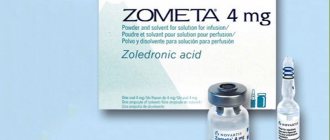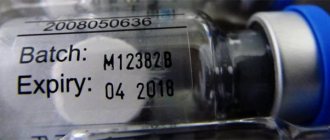Pharmacodynamics
Omeprazole inhibits the enzyme H+-K+-ATPase (“proton pump”) in the parietal cells of the stomach and thereby blocks the final stage of hydrochloric acid synthesis. This leads to a decrease in the level of basal and stimulated secretion, regardless of the nature of the stimulus. After a single oral dose of the drug, the effect of omeprazole occurs within the first hour and continues for 24 hours, the maximum effect is achieved after 2 hours. In patients with duodenal ulcer, taking 20 mg of omeprazole maintains intragastric pH = 3 for 17 hours. After stopping the intake of the drug, secretory activity is completely restored after 3–5 days.
Omez 40 mg 1 pc. lyophilisate for the preparation of solution for infusion
pharmachologic effect
Gastric gland secretion reducer - proton pump inhibitor.
Composition and release form Omez 40 mg 1 pc. lyophilisate for the preparation of solution for infusion
Lyophilisate for preparing solution for infusion - 1 vial:
- Active ingredients: omeprazole - 40 mg.
- Excipients: sodium hydroxide - 5.28 mg, disodium edetate - 1 mg.
Flat glass bottles (1) - cardboard packs.
Description of the dosage form
Lyophilisate for the preparation of a solution for infusion in the form of a homogeneous porous cake or parts thereof or in the form of a white or almost white powder.
Directions for use and doses
In case of severe exacerbation of peptic ulcer, reflux esophagitis and NSAID gastropathy, for patients for whom oral administration of the drug is not indicated, the recommended daily dose of Omez® is 40 mg for administration in the form of an intravenous infusion.
For Zollinger-Ellison syndrome, the drug is prescribed at an initial dose of 60 mg/day. The dose should be selected individually; higher doses may be prescribed (80-120 mg/day). If the daily dose is more than 60 mg, it should be divided into 2-3 infusions during the day.
For Mendelssohn's syndrome, the drug is prescribed at night at a dose of 40 mg and at least 2 hours before anesthesia/surgery at a dose of 40 mg.
In elderly patients there is no need to adjust the dose.
Pharmacodynamics
Antiulcer drug, specific proton pump inhibitor. Inhibits the activity of H+-K+-ATPase in the parietal cells of the stomach, blocking the final stage of hydrochloric acid secretion, thereby reducing acid production. Reduces basal and stimulated secretion regardless of the nature of the stimulus.
Omeprazole is a prodrug and is activated in the acidic environment of the secretory tubules of the parietal cells of the stomach.
The antisecretory effect after taking a dose of 20 mg occurs within the first hour, the maximum effect is after 2 hours. Inhibition of 50% of maximum secretion lasts 24 hours.
A single dose per day provides rapid and effective suppression of daytime and nighttime gastric secretion, reaching its maximum after 4 days of treatment and disappearing by the end of 3-4 days after the end of administration.
In patients with duodenal ulcers, 20 mg omeprazole maintains gastric pH at 3 for 17 hours.
Pharmacokinetics
Distribution and metabolism
Binds to plasma proteins by 90-95% (albumin and acid alpha glycoprotein).
Almost completely metabolized in the liver with the participation of the cytochrome P450 enzyme system with the formation of 6 pharmacologically inactive metabolites (including hydroxyomeprazole, sulfide and sulfone derivatives). A significant part of the metabolism of omeprazole depends on the polymorphically expressed specific isoform CYP2C19 (S-mephenytoin hydroxylase), which is responsible for the formation of hydroxyomeprazole, the main plasma metabolite. It is an inhibitor of the CYP2C19 isoenzyme.
Removal
T1/2 for the final phase of AUC after intravenous administration of omeprazole is approximately 40 minutes (for liver failure - 3 hours); the total plasma clearance is from 0.3 to 0.6 l/min. There is no change in the T1/2 value during treatment.
Excreted in urine (70-80%) and bile (20-30%).
Pharmacokinetics in special clinical situations
In chronic renal failure, excretion decreases in proportion to the decrease in creatinine clearance.
In elderly patients, excretion decreases and bioavailability increases.
Indications for use Omez 40 mg 1 pc. lyophilisate for the preparation of solution for infusion
As an alternative to oral therapy if it is not possible:
- for peptic ulcers of the stomach and duodenum (including prevention of relapses);
- for gastroesophageal reflux disease (GERD);
- for hypersecretory conditions (Zollinger-Ellison syndrome, stress ulcers of the gastrointestinal tract, polyendocrine adenomatosis, systemic mastocytosis);
- for the prevention and treatment of damage to the mucous membrane of the stomach and duodenum caused by the use of nonsteroidal anti-inflammatory drugs (NSAID gastropathy): dyspepsia, erosion of the mucous membrane, peptic ulcer;
- to prevent aspiration of acidic stomach contents into the respiratory tract during general anesthesia (Mendelssohn syndrome).
Contraindications
Hypersensitivity to omeprazole or other components of the drug.
Concomitant use with erlotinib, posaconazole, nelfinavir and atazanavir.
Breastfeeding period.
Children under 18 years of age (efficacy and safety have not been established for this dosage form).
Carefully
Renal failure (no dose adjustment of omeprazole is required).
Liver failure.
Osteoporosis. Although a causal relationship between the use of omeprazole and osteoporotic fractures has not been established, patients at risk of developing osteoporosis or osteoporotic fractures should be under appropriate clinical supervision.
Pregnancy.
Concomitant use with clopidogrel, itraconazole, warfarin, cilostazol, diazepam, phenytoin, saquinavir, tacrolimus, clarithromycin, voriconazole, rifampicin, St. John's wort preparations.
Application of Omez 40 mg 1 pc. lyophilisate for the preparation of solution for infusion during pregnancy and lactation
The use of the drug during pregnancy is possible only if the expected benefit to the mother outweighs the potential risk to the fetus.
During lactation, breastfeeding should be stopped.
special instructions
Before starting therapy, it is necessary to exclude the presence of a malignant process (especially with a stomach ulcer), because Treatment, masking symptoms, can delay the correct diagnosis. If after starting the use of omeprazole there is no improvement in the condition or the heartburn becomes even worse, it is necessary to interrupt treatment and consult a doctor.
Patients over the age of 45 with symptoms of heartburn, suffering from heartburn for the first time, can use omeprazole only after consulting a doctor. Omeprazole should be used under the supervision of a physician if one of the following symptoms or conditions is present: decreased body weight without an obvious reason and/or lack of appetite, fatigue; prolonged abdominal pain; history of gastric and/or duodenal ulcer; frequent vomiting; swallowing disorder/pain when swallowing; hematemesis/melena/rectal bleeding; persistent heartburn (more than 3 months); chronic cough, difficulty breathing; jaundice; chest pain (especially chest tightness or pain radiating to the neck or upper limbs) if associated with sweating, difficulty breathing, or dizziness; history of stomach or esophageal cancer in close relatives; liver failure.
If any of these symptoms/conditions occur, consult your doctor immediately.
Risk of hip, wrist and vertebral fractures. Proton pump inhibitors, especially when used in high doses and long-term use (>1 year), may moderately increase the risk of hip, wrist, and vertebral fractures, especially in older patients or those with other risk factors. Observational studies suggest that proton pump inhibitors may increase the overall risk of fracture by 10–40%. Patients at risk of developing osteoporosis should be treated in accordance with the latest clinical guidelines.
Hypomagnesemia. Severe hypomagnesemia has been reported in patients taking omeprazole for at least 3 months. Clinical manifestations such as fatigue, tetany, delirium, convulsions, dizziness and ventricular arrhythmia may develop as vague symptoms, which may lead to late diagnosis of this dangerous condition. Most patients achieve improvement after using magnesium-containing drugs and discontinuing proton pump inhibitors. In patients who are planning long-term therapy or who are prescribed omeprazole with digoxin or other drugs that can cause hypomagnesemia (for example, diuretics), plasma magnesium levels should be assessed before starting therapy and regularly during treatment.
Effect on the absorption of vitamin B12. Omeprazole, like all drugs that reduce acidity, can lead to decreased absorption of vitamin B12 (cyanocobalamin), because it causes hypo- or achlorhydria. This must be remembered in patients with a reduced supply of vitamin B12 in the body or with risk factors for impaired absorption of vitamin B12 during long-term therapy.
Other effects associated with inhibition of hydrochloric acid secretion. Patients taking drugs that reduce the secretion of gastric glands for a long period of time are more likely to experience the formation of glandular cysts in the stomach, which go away on their own with continued therapy. These phenomena are caused by physiological changes resulting from inhibition of hydrochloric acid secretion.
A decrease in the secretion of hydrochloric acid in the stomach under the influence of proton pump inhibitors leads to an increase in the growth of abnormal intestinal microflora, which in turn can lead to a slight increase in the risk of developing intestinal infections caused by bacteria of the genus Salmonella spp. and Campylobacter spp., and also possibly Clostridium difficile in hospitalized patients.
Cutaneous form of subacute lupus erythematosus. The use of proton pump inhibitors has been associated with very rare cases of subacute cutaneous lupus erythematosus. If skin lesions develop, especially in areas exposed to sunlight, accompanied by joint pain, the patient should immediately consult a doctor about possible discontinuation of omeprazole. A history of subacute cutaneous lupus erythematosus after the use of proton pump inhibitors may increase the risk of developing this disease when using omeprazole.
Effect on laboratory test results. Due to decreased secretion of hydrochloric acid, the concentration of chromogranin A (CgA) increases. Increased concentrations of CgA may affect the results of examinations for the detection of neuroendocrine tumors. To prevent this effect, it is necessary to temporarily stop using omeprazole 5 days before determining the CgA concentration.
Impact on the ability to drive vehicles and machinery. There is no data on the effect of omeprazole on the ability to drive a car or use other machinery. However, due to the fact that dizziness, blurred vision and drowsiness may occur during therapy, caution should be exercised when driving vehicles and machinery.
Overdose
According to clinical studies, with intravenous administration of up to 270 mg of the drug per day and at a dose of up to 650 mg for three days, no dose-dependent side effects were identified.
Symptoms: confusion, blurred vision, drowsiness, dry mouth, headache, nausea, tachycardia, arrhythmia.
Treatment: symptomatic. Hemodialysis is not effective enough.
Side effects Omez 40 mg 1 pc. lyophilisate for the preparation of solution for infusion
The frequency of adverse drug reactions is presented in accordance with the following gradation: very often (>1/10); often (≥1/100,
Disorders of the skin and subcutaneous tissues: infrequently - dermatitis, itching, skin rash, urticaria; rarely - alopecia, photosensitivity reactions, erythema multiforme, Stevens-Johnson syndrome, toxic epidermal necrolysis.
Musculoskeletal and connective tissue disorders: uncommon – fractures of the hip, wrist bones, vertebrae; rarely – arthralgia, myalgia, muscle weakness.
Nervous system disorders: often – headache; uncommon – dizziness, paresthesia, drowsiness; rarely – taste disturbance.
Mental disorders: infrequently – insomnia; rarely - increased excitability, aggressiveness, impaired consciousness, depression, hallucinations.
Gastrointestinal disorders: often – abdominal pain, constipation, diarrhea, flatulence, nausea, vomiting; rarely - dry mouth, stomatitis, gastrointestinal candidiasis, microscopic colitis.
Disorders of the liver and biliary tract: infrequently - increased activity of liver enzymes; rarely - hepatitis with/without jaundice, liver failure, encephalopathy in patients with previous severe liver diseases.
Disorders of the genital organs and breast: rarely – gynecomastia.
Blood and lymphatic system disorders: leukopenia, thrombocytopenia, agranulocytosis, pancytopenia.
Immune system disorders: rarely - hypersensitivity reactions: fever, angioedema, anaphylactic reaction / anaphylactic shock.
Disorders of the respiratory system, chest and mediastinal organs: rarely - bronchospasm.
Renal and urinary tract disorders: rarely – interstitial nephritis.
Hearing and labyrinthine disorders: uncommon – vertigo.
Visual disturbances: rarely – blurred vision.
Metabolic and nutritional disorders: rarely – hyponatremia; very rarely - hypomagnesemia, hypocalcemia due to severe hypomagnesemia, hypokalemia due to hypomagnesemia.
General disorders: infrequently – malaise; rarely – increased sweating, peripheral edema.
Drug interactions
With simultaneous use, Omez® may reduce the absorption of ampicillin esters, iron salts, itraconazole and ketoconazole, because Omeprazole increases gastric pH.
As an inhibitor of cytochrome P450, omeprazole may increase the concentration and reduce the excretion of diazepam, indirect anticoagulants (warfarin), phenytoin (drugs metabolized in the liver by CYP2C19), which in some cases may require a reduction in the doses of these drugs.
At the same time, long-term use of omeprazole at a dose of 20 mg 1 time / day in combination with caffeine, theophylline, piroxicam, diclofenac, naproxen, metoprolol, propranolol, ethanol, cyclosporine, lidocaine, quinidine and estradiol did not lead to a change in their plasma concentrations.
Plasma concentrations of omeprazole and clarithromycin increase during concomitant oral administration of these drugs, while there is no evidence of interaction of omeprazole with metronidazole and amoxicillin.
Pharmacokinetics
Omeprazole is rapidly absorbed from the gastrointestinal tract, Cmax in plasma is achieved in 0.5–1 hour. Bioavailability is 30–40%. Plasma protein binding is about 90%. Omeprazole is almost completely metabolized in the liver. T1/2 - 0.5–1 hour. Excreted mainly by the kidneys in the form of metabolites. In chronic renal failure, excretion decreases in proportion to the decrease in creatinine clearance. In elderly patients, excretion decreases and bioavailability increases. In case of liver failure, bioavailability is 100%, T1/2 is 3 hours.
Side effects
In rare cases, the following usually reversible side effects may occur.
From the digestive organs:
diarrhea or constipation, nausea, vomiting, flatulence, abdominal pain, dry mouth, taste disturbances, stomatitis, transient increase in the level of liver enzymes in plasma; in patients with previous severe liver disease - hepatitis (including jaundice), impaired liver function.
From the nervous system:
headache, dizziness, agitation, drowsiness, insomnia, paresthesia, depression, hallucinations; in patients with severe concomitant somatic diseases, in patients with previous severe liver disease - encephalopathy.
From the musculoskeletal system:
muscle weakness, myalgia, arthralgia.
From the hematopoietic system:
leukopenia, thrombocytopenia; in some cases - agranulocytosis, pancytopenia.
From the skin:
itching; rarely (in some cases) - photosensitivity, erythema multiforme, alopecia.
Allergic reactions:
urticaria, angioedema, bronchospasm, interstitial nephritis and anaphylactic shock.
Other:
blurred vision, peripheral edema, increased sweating, fever, gynecomastia; rarely - the formation of gastric glandular cysts during long-term treatment (a consequence of inhibition of hydrochloric acid secretion, which is benign and reversible).
Directions for use and doses
Inside,
with a small amount of water (the contents of the capsule must not be chewed).
Duodenal ulcer in the acute phase
- 1 caps. (20 mg) per day for 2–4 weeks (in resistant cases - up to 2 capsules per day).
Gastric ulcer in the acute phase and erosive-ulcerative esophagitis
- 1-2 caps. per day for 4–8 weeks.
Erosive and ulcerative lesions of the gastrointestinal tract caused by taking NSAIDs
- 1 caps. per day for 4–8 weeks.
Helicobacter pylori eradication
- 1 caps. 2 times a day for 7 days in combination with antibacterial agents.
Anti-relapse treatment of gastric and duodenal ulcers
- 1 caps. per day.
Anti-relapse treatment of reflux esophagitis
- 1 caps. per day for a long time (up to 6 months).
Zollinger-Ellison syndrome
— the dose is selected individually depending on the initial level of gastric secretion, usually starting from 60 mg/day. If necessary, the dose is increased to 80–120 mg/day, in which case it is divided into 2 doses.
Omez in ampoules: instructions for use
Before starting use, you must carefully study the instructions for use, which contain detailed information about the drug and how to use it.
Mode of application
Omez in ampoules is intended exclusively for intravenous administration, which can be carried out by injection or infusion (drip).
- Injection. The lyophilisate contained in one bottle must be diluted in 10 ml of water for injection, so that 1 ml of liquid contains 4 mg of omeprazole. The resulting solution is injected into the vein slowly over five minutes. It cannot be stored.
- Dropper. Prepare the same solution as for injection (with a concentration of the active substance of 4 mg/ml), then dilute it with sodium chloride or glucose so that the concentration becomes 0.40 mg/ml. The resulting substance is injected into a vein by infusion over 20-30 minutes.
Dosage regimen and overdose
The dosage must be determined by the doctor, but there are some recommendations.
| Pathology | Recommended dose |
| Ulcer during exacerbation; Reflux esophagitis | 40 mg per day via dropper, subsequently switching to oral administration of the drug (approximately after 2-3 days) |
| Pancreatic adenoma | 60 mg per day; Possible increase - 80-100 mg; The increased dose must be divided into several infusion doses. |
| Prevention of gastric fluid entering the respiratory tract | 40 mg two hours before surgery (injection or IV) |
Clinical studies have shown that after a single administration of 270 mg of the drug per day and 650 mg for three days, no dose-related side effects occurred. There is no antidote for the product. Omez binds to plasma proteins, making dialysis useless. If the dose is exceeded, the doctor will select treatment based on the symptoms.
Adverse reactions
Side effects make themselves felt, as a rule, with prolonged use of the drug. The following unpleasant consequences can be identified, manifested by different systems and organs.
- Gastrointestinal tract:
- abdominal pain;
- digestive disorders;
- increased flatulence.
- Central nervous system:
- headaches;
- dizziness;
- weakness;
- sleep problems;
- depression, excitability, hallucinations - in severe cases.
- Hematopoiesis:
- changes in the cellular composition of the blood (very rare).
- Digestive system:
- impaired liver function;
- encephalopathy;
- hepatitis with or without jaundice;
- liver failure.
- Genitourinary system:
- kidney dysfunction.
In addition to these symptoms, allergic reactions in the form of rash or itching are possible. In rare cases, patients also experience blurred vision, bronchospasm, and increased fatigue.
If these side effects occur, you should seek medical help immediately.
special instructions
Before starting therapy, it is necessary to exclude the presence of a malignant process (especially with a stomach ulcer), because Treatment, masking symptoms, can delay the correct diagnosis.
Taking with food does not affect effectiveness.
If you have difficulty swallowing a whole capsule, you can swallow its contents after opening or dissolving the capsule, or you can mix the contents of the capsule with a slightly acidified liquid (juice, yogurt) and use the resulting suspension for 30 minutes.
In patients with severe liver failure, the daily dose should not exceed 20 mg.
Terms of sale and storage
To purchase Omez at a pharmacy, you will need a prescription form filled out by your attending physician.
The drug is stored for two years in a dry place, protected from moisture and light, and also inaccessible to children. Recommended storage temperature is 25 degrees.
Omez is a drug that quite quickly helps fight gastrointestinal diseases. Its effectiveness is confirmed by positive patient reviews. However, it is important to remember that before using this medication, like any other drug, you should definitely consult a specialist.





